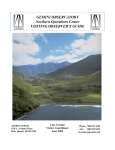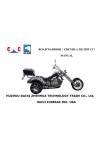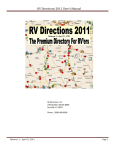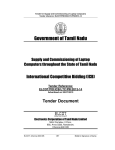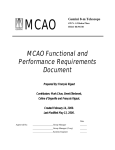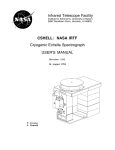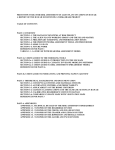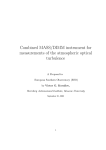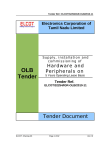Download VISITORS GUIDE Gemini North
Transcript
VISITORS GUIDE to Gemini North GEMINI NORTH 670 N. A’ohoku Place Hilo, Hawaii 96720-2700 April 2012 Visitor Coordinator Adrienne Notley Phone: 808-974-2500 Fax: 808-974-2648 [email protected] WELCOME TO THE BIG ISLAND! Congratulations on being awarded time to observe on the Gemini telescope. It is important that you, as Principal Investigator, relay all pertinent information required for your observing run, and complete all forms requested by Gemini in order for us to provide the support to enable your observations to be undertaken successfully. All visiting observers will be given an operations and safety briefing prior to their proceeding to the summit of Mauna Kea. This is mandatory. Included in this document is pertinent information in preparation for your observing run. It is imperative that you review the contents. It will help you understand the risks of working at the summit of Mauna Kea, and guide you through the operations of Gemini Observatory. Please remember to log on to the following site and send in the required forms: http://www.gemini.edu/sciops/visiting-gemini/instructions-visitors?q=node/10992 Good luck on a successful observing run! Aloha and welcome to Hilo on the Big Island of Hawaii! DIRECTIONS FROM HILO INTERNATIONAL AIRPORT To Gemini Observatory Northern Operations Center • Stay on the exit road from the airport until you reach a traffic light. At the traffic light, turn LEFT onto Highway 11 also known as Kanoelehua Avenue. • Stay on Highway 11, in the right hand lane, pass three stop lights until you reach the fork at Puainako (Prince Kuhio Plaza is on your left and Tesoro gas station in on your right) • At the light, bear to your RIGHT onto Puainako. Continue on Puainako for about 3 miles, until you reach Komohana Street at the top of the hill, where Puainako ends at a “T” intersection. Turn RIGHT. • Stay in the right hand lane on Komohana Street until you see the University Park sign on your right (about a ½ mile distance). Turn RIGHT on Nowelo Street. • Proceed downhill on Nowelo Street. Turn LEFT on A’ohoku Place. The first building on your left, with seven flag poles and seven flags, a red roof, is the Gemini Observatory. Turn left up the hill onto the drive way and park in any available parking space. Enter the lobby through the front glass double doors. IN HILO, CALL 974-2500 IF YOU NEED FURTHER DIRECTIONS OR HAVE QUESTIONS. To Hotels on Banyan Drive • Stay on the exit road from the airport until you reach a traffic light. At the traffic light, turn RIGHT onto Highway 11, also known as Kanoelehua Avenue. • Stay on Highway 11 to the next traffic light. Be sure to stay in the middle lane. At the light, go straight onto what now becomes Banyan Drive. Continue on Banyan Drive to your hotel. All hotels are located on the right side. MAP OF HILO For information on Hawaii’s Island of Adventure, go to: http://www.bigisland.org/ For a Dining Experience, go to: http://www.downtownhilo.com/Guides/RestaurantGuide/tabid/66/Default.aspx http://wheretraveler.com/classic/us/ha/hawaii/dining/index.html?gclid=CIqz_JLln58CFSgVagodb1L1_g HOTEL INFORMATION Hotels in Hilo Hotels in Kona Hilo Hawaiian Hotel www.castleresorts.com/Home/accommodations /hilo-hawaiian-hotel 71 Banyan Drive, Hilo, Hawaii 96720 Phone: (808) 935.9361, Fax: (808)969-6472 Corporate rate starting from $95.00 plus taxes. Contact Gemini Observatory for reservations. Standard Room, King bed, No smoking . Kona Seaside Hotel http://seasidehotelshawaii.com//HotelKona.aspx (800) 560-5558 - Indicate Gemini Observatory has a preferred card for discount rates starting @ $74 + Tax for Kona. Naniloa Volcanoes Resort www.volcanohousehotel.com/naniloa_volcanoes _resort.htm 93 Banyan Drive, Hilo 808-969-3333 (808) 969-3333 - Request Gemini corporate rate (starting from $109 plus tax). Uncle Billy’s Hilo Bay Hotel www.unclebilly.com 87 Banyan Drive, Hilo, (808) 935-0861 (808) 961-5818 - No corporate rate – request lowest available rate. Hilo Seaside Hotel http://seasidehotelshawaii.com/HotelHilo.aspx (808) 935-0821 - Indicate Gemini Observatory has a preferred card for discount rates starting @ $69 plus taxes for Hilo. Dolphin Bay Hotel www.dolphinbayhotel.com 333 Iliahi St, Hilo 808-935-1466, Toll Free (877) 935-1466. Royal Kona Resort http://www.hawaiihotels.com/Main/Index.cfm?I D=300&Ref=RKR 75-5852 Alii Drive Kailua-Kona, HI 96740 800-222-5642, (808) 329-3111 King Kamehameha's Kona Beach Hotel http://www.konabeachhotel.com/ 75-5660 Palani Road, Kailua-Kona, HI, 96740 Telephone: (808) 329-2911 Facsimile: (808) 329-4602 E-Mail: [email protected] Hotels in Honolulu Honolulu Airport Hotel or Best Western Plaza Hotel Phone: 1-800-800-3477. Corporate rates starting from $99 plus taxes. Contact Gemini Observatory for reservations. NOTE: The above hotel rates are corporate rates for Gemini Observatory, and are subject to an 11.42% combined state and room tax and are subject to change without notice. BED & BREAKFAST LOCATIONS The Bay House www.bayhousehawaii.com 42 Pukihae St, Hilo 808-961-6311 or 888-235-8195 All rooms from $150 per night. Hilo Honu Inn www.hilohonu.com 465 Haili St, Hilo 808-935-4325 Rates range from $140 - $250 per night. Holmes Sweet Home www.holmesbandb.com/ 808-934-0711 Rooms $80+/night. John and Charlotte Holmes: [email protected] Maureen's B&B www.maureenbnb.com 1896 Kalanaianaole Ave, Hilo 808-935-9018 or 800-935-9018 Single rooms range from $60 - $110 per night. Pakalana Inn http://pakalanainn.com/ 132 Punahoa Street Hilo, Hawaii 96720, 808-935-0709 [email protected] Single rooms range from $100+ per night. Shipman House Inn www.hilo-hawaii.com 131 Kaiulani St, Hilo 808-934-8002 Rooms $209 - $249/night, double Waterfalls Inn B&B www.waterfallsinn.com/ 240 Kaiulani St, Hilo 808-969-3407 Rooms $120/night. Wild Ginger Inn www.wildgingerinnhilo.com 100 Puueo St, Hilo 808-935-5556 Rooms $69+/night. HOSTELS Hilo Bay Hostel www.hawaiihostel.net 101 Waianuenue Ave., Hilo 808-933-2771 Dorms $25, Private Rooms from $65. Arnotts Lodge & Hiking Adventures www.arnottslodge.com/home.html 98 Apapane Road, Hilo, HI 96720, 808-9697097 Rates: Single: $60; Double $60; Suite $130. Hawaii Island Bed & Breakfast Association http://www.stayhawaii.com/index.php?action=searchresults&pclass[]=2 CAR RENTAL AGENCIES Except for Harper Car & Truck agency listed below, car rental agencies may prohibit the use of their vehicles on the Saddle and Mauna Kea Access Roads. A four-wheel drive vehicle is required to drive from Hale Pohaku to the summit of the mountain where the telescopes are located, as the road above 9,300 feet has a long unpaved portion, which is often in poor condition. Gemini does not provide a vehicle for observers, but will provide transportation between Hale Pohaku and the summit of Mauna Kea with Gemini staff. It is suggested that you rent a vehicle to get to Hale Pohaku, or it may be possible to ride up with Gemini staff pending the vehicle schedule. If Gemini makes the reservation for you, please be aware that this is your individual reservation, and you will need to make provisions for insurance because you will not be covered by any Gemini policy. NATIONAL CAR RENTAL: 1-800-227-7368; Hilo 1-808-935-0891 http://www.nationalcar.com/ National allows cars booked by Gemini with our corporate discount # to be driven to Hale Pohaku. If the rental is driven up to the summit, the renter is responsible for any damages – any insurance which is purchased by the renter will not cover damages incurred while driving between Hale Pohaku & the summit. To benefit from the corporate discount, please contact our Visitor Coordinator to make these reservations with National. HARPER CAR & TRUCK: 1-800-852-9993; Hilo 1-808-969-1478 http://www.harpershawaii.com/ Harper will allow only their four-wheel drive vehicles on Saddle Road and Mauna Kea Access Road to Hale Pohaku and to the summit of Mauna Kea. Other Car Rental Agencies: ALAMO: 1-800-327-9633; Hilo 961-3343 AVIS: 1-800-831-8000; Hilo 935-1290 BUDGET: 1-800-527-7000; Hilo 935-7293 DOLLAR: 1-800-800-4000; Hilo 961-6059 HERTZ: 1-800-654-3011; Hilo 935-2896 Make sure you check the vehicle carefully for any damage prior to accepting the rental. DRIVING TO MAUNA KEA DIRECTIONS TO HALE POHAKU From Hilo, take the Puainako Extension (Hwy 2000) which merges with Saddle Road (Hwy 200). Just before the 28 mile marker, there is a road to the right and a street sign that says Mauna Kea Access Road. Make the right turn. Hale Pohaku is about 6 miles up the road on the right side of the road. The drive takes approximately 1 hour. From the Kona side of the island, take Highway 190 heading North toward Waimea. Just before the 6 mile marker, there is a turnoff on the right for Saddle Road (Hwy 200). Take Saddle Road until just after the 28 mile marker. Turn left onto the Mauna Kea Access Road. Hale Pohaku is about 6 miles up the road on the right side of the road. From Waimea, the trip takes about 1 hour, from Waikoloa, the trip takes about 1 1/2 hours, and from Kona, the trip takes about 2 hours. DRIVING The summit access road is winding, steep and dangerous. Weather can deteriorate rapidly and ice, snow, wind, or fog are factors that require special attention. Speed limits are for passenger and vehicle safety and must be obeyed. There are grades up to 17% on the access road, and brakes will overheat if lower gears are not used on the descent. Always downshift to keep engine rpms between 3000 and 4000, and never in the “red zone”. Driving at high altitude carries many risks. Lower oxygen can impair judgment and create fatigue. Blinding snow or white-out conditions can lead to severe vertigo. Extreme cold and wind chill can lead to serious hypothermia and frostbite. Do not take chances! If at all possible, do not drive to Mauna Kea by yourself – travel with someone, or follow another observatory vehicle. Carry a cell phone, and keep it well charged. If an accident or a vehicle malfunction leaves you stranded: • Call 911 from your cellular phone. • If you can move your vehicle even a little, try to get it safely off the side of the road so it will not be a hazard to other vehicles. • Stay with your vehicle until help arrives so rescuers can find you more easily. HALE POHAKU, THE MID-LEVEL FACILITY Located at the 9,300 ft elevation is Hale Pohaku, the mid-level facility. To acclimate to the altitude, you must spend at least one night at Hale Pohaku before your observing run. The dormitory buildings provide sleeping quarters. Each room contains a double bed, air humidifier, heater, desk, lamp, chair, and a “Hale Pohaku User’s Manual”. Bed linen, towels, soap and washcloths are provided, but personal laundry service is not available. There is no daily maid service. No toiletries , stationery, or postage stamps are available at Hale Pohaku, so please bring a sufficient supply with you. Laundry facilities are available. Access to HP is limited to Observers and Observatory guests. To gain entry into HP you must obtain the key lock combination from Gemini HBF. Upon check in, you will receive two keys, one for your dormitory room, and one for the main dormitory building entrance door. Check out time is 2:00 p.m. To avoid paying for an additional night, you must return your keys to the front desk at or before that time. Lunch and dinner are served, cafeteria style, from 12 noon to 1:00 p.m. and from 4:00 to 6:00 p.m. Breakfast is served from 6:00 to 8:30 a.m. Meals are included with the cost per night lodging fee of $105, starting with dinner upon check-in and ending with lunch upon check-out. Any meal consumed prior to check-in and after check-out is subject to an additional charge. If you require vegetarian meals, or are on another diet plan, please let the cooks know and they will prepare a meal for you. If you have a change in plan, please inform the Hale Pohaku staff as soon as possible. Please write or print legibly when signing for meals! HP LOCKBOX: Located at the front desk, the Lock Box contains dorm keys for last minute check-ins. Remove one key only, sign the form and check-in with office the following day. GEMINI OFFICE: Gemini maintains an office workspace in the main Hale Pohaku building. This room is for the use of Gemini employees. To gain access to the Gemini office at HP you must obtain the key lock combination from Gemini HBF. Please remember to always keep the door locked when you leave. INTERNET ACCESS: See the Hale Pohaku User’s Manual for information. COLD WEATHER GEAR: Warm clothes are essential. Warm shoes with good insulation are important. Parka and overalls can be rented at Hale Pohaku for $6.00 each, per day. TELEPHONE: The number is (808) 935-7606. Local phone calls (Hawaii Island) can be made by first dialing 9. Long distance calls can only be made from the Gemini office or with a calling card. Meeting Area for Pre-Bid Mtg Parking for Pre-Bid Mtg Hale Pohaku PREPARING FOR THE SUMMIT OF MAUNA KEA Be prepared for the altitude and the cold at the summit of Mauna Kea. At the altitude of 13,800 feet, weather at the Mauna Kea summit can be severe, especially during the winter months. Conditions can change radically in a very short period of time. We suggest that you prepare for weather conditions to deteriorate to 20 degrees F, with 70 mph winds possibly blowing snow. Wind chill and high altitude can make it seem much colder. We suggest you bring the following: Warm clothes, skiing style, including hat and gloves Warm shoes with good insulation Lip balm, lotion for dry skin, & sunscreen Wind-proof Jacket (gusts 35 mph or more; sustained winds above 50 mph are not uncommon) Any exposed skin will quickly freeze. Never leave the building without proper attire. Hypothermia is life-threatening. Long duration flashlight and batteries Analgesic for headaches (aspirin or acetaminophen) Dark sunglasses Remember, you can always take extra clothes off, but you cannot put them on if you do not bring them! STAY WARM! "The use of alcohol or illegal drugs of any kind is not permitted on AURA property, including the summits. All visitors and employees are expected to abide by this rule. Failure to do so may result in denial of access to Gemini facilities.“ The altitude may also aggravate pre-existing disease, particularly cardio-vascular and respiratory diseases. Individuals with these conditions are advised to bring the above information to the attention of his/her medical practitioner and to seek medical advice and clearance before visiting the summit. It is recommended for any visitor to Mauna Kea to seek medical advice and clearance before visiting the summit. Under NO circumstances will Gemini allow visitors under the age of sixteen (16) to visit the Gemini site. AURA/GEMINI DOES NOT ACCEPT ANY LIABILITY FOR VISITORS TO MAUNA KEA WITH RESPECT TO THE POTENTIAL ADVERSE EFFECTS OF ALTITUDE. IF YOU INTEND TO VISIT THE TELESCOPE SITE, YOU ARE REQUIRED TO SIGN A DECLARATION AND WAIVER. YOU THEREFORE ASSUME ALL RISK. HIGH ALTITUDE HEALTH HAZARDS There are risks in going to high altitude and it’s important to understand these risks. The summit of Mauna Kea is a hostile and potentially hazardous working environment. All Gemini staff need to pass a High Altitude medical examination in order to be allowed to work up at the telescope. This physical will not be required for observing visitors; however, Gemini will require that the GN Visitor’s Safety Information document be signed by all visitors prior to going to Mauna Kea. This disclaimer transfers the emphasis of awareness of the potential medical difficulties and their symptoms from the administration directly to the observers themselves. It is the observers’ responsibility to ensure they are sufficiently healthy to work on Mauna Kea. Altitude sickness is primarily caused by a lack of oxygen in the body – hypoxia. At the summit of Mauna Kea, the oxygen content of the reduced atmosphere is a mere 60% of that at sea level. The major cause of altitude illnesses is ascending to the summit too fast. A preventive measure to altitude illness is acclimation. Your body can adapt to the decrease in oxygen at a specific altitude in 1-3 days. Gemini requires that all observers acclimate at Hale Pohaku (9,300 feet) for 24 hours before proceeding to the summit for their observing run. Gemini summit staff are certified in first aid and CPR. First aid kits are located in the Operations Control Room, Level 1 outside the workshop, Level 5 outside the elevator vestibule, and all Gemini vehicles. Emergency oxygen is available in the Operations Control Room and Level 5 outside the elevator vestibule. Please inform the Support Scientist or System Support Associate whenever oxygen is consumed. It is imperative that our supplies are ready and available when required. If you feel the onset of any unusual feelings or symptom, let someone know immediately. MINOR SYMPTOMS/SIGNS: Mild shortness of breath, dizziness, lightheadedness, headaches, nausea, change in visual activity, palpitations, chest tightness. STEPS TO BE TAKEN: Inform Duty Officer, Drink Fluids (water or Gatorade), take Aspirin or Tylenol, use deep or pressure breathing, lie down until you feel better. MAJOR SYMPTOMS/SIGNS: Visual Disturbance, Paralysis, Loss of Coordination, Fainting, Collapse, Seizures, Slow or Rapid Heart Beat, Unrelenting Nausea or Vomiting. STEPS TO BE TAKEN: Use supplemental oxygen, leave the summit immediately, follow the MKSS Emergency Procedure Plan, and call 911. GUIDELINES FOR MINIMIZING RISK AT THE MAUNA KEA SUMMIT DRINK WATER…the human body shifts large volumes of body water and to help with short-term adjustments to altitude. Give your body water to work with and to cope with losses into the very dry air. If you start to get a pounding, hang-over type headache, drink three or four cups of plain water; it often works in 4-5 minutes. LEARN HOW TO BREATHE…take slow, even breaths. MOVE SLOWLY…always pace yourself at the summit. Sit down. Don’t stand for long periods. STAY RESTED…avoid exhausting tasks/parties and short sleep the day before you are scheduled for a trip to the summit. This provides more cardio-respiratory reserves for adjustment to altitude stress. AVOID ALCOHOL…for at least 10 hours prior to ascent. This avoids dehydration and irritation of the arteries of the brain that will be forced to adjust to hypoxia. AVOID MARIJUANA…it stays with an individual for 5-6 days and can be an unpredictable, extremely potent constrictive agent for the coronary arteries. It has caused sudden death by unpredictably shutting off the blood supply in the hearts of even young, healthy people without warning. AVOID TOBACCO SMOKING…nicotine constricts arteries and further inhibits adjustments to the need for increased blood flow. Stop smoking 48 hours before ascent to allow carbon monoxide in your bloodstream to dissipate. AVOID HEAVY MEALS…before ascent to the summit, since this tends to tie up a significant part of the available blood flow for longer than light meals (of high carbohydrate items such as pasta, rice, or other starch). Avoid skipping meals or eating or drinking nothing but sugared snacks or drinks; sharp changes in blood sugar can trigger increased altitude stress. AVOID UNPROTECTED EYE EXPOSURE…to glare and bright sunlight by wearing dark lenses, preferably UV-coated lenses. This reduces fatigue and will prevent the loss of 50% of night vision for up to two nights after glare exposure of only 1 hour. It also blocks out the significantly greater ultraviolet exposure that Hawaii’s ideal astronomical conditions permit, possibly leading to early cataracts. You may wish to wear sunscreen, as the sun can burn even in cold temperatures Excerpted from: “High Altitude Safety Protocol” by Mountain Medical Services. NIGHT SHIFT PROCEDURES Safety and Health are paramount at our AURA/Gemini facilities. While we work diligently to maintain a safe and healthy environment for workers, the site may still pose safety hazards. As a result, it is imperative that you proceed with caution at all times. At Hale Pohaku Check-in at Hale Pohaku by 4:00 p.m. If prior arrangements have not been made for you to meet with your Contact Scientist, please leave word with the front desk for the SOS or Contact Scientist that you have checked in at Hale Pohaku. Arrangements need to be made with the Contact Scientist or SOS to ride up together to the summit. Leave your rental car at Hale Pohaku in the lower parking lot southwest of the main building. Be sure it is locked. At the Summit Each Night Shift has a trained Duty Officer. The Duty Officer is responsible for knowing who is on the site, where all exits are located, areas where work is being performed, how to turn lights on and off, what to do in an emergency, and how to secure the building when exiting. The evening shift SOS (System Support Associate) is usually the designated Duty Officer. Always do the following when at the summit: • Sign-in on the white board upon arrival, next to the vehicle number you came in • Hang the vehicle keys on the respective key hook • Pick-up a two-way radio (and carry your own flashlight) • Notify the SOS/Duty Officer of your whereabouts. The Contact Scientist or the SOS will guide you through this process. On your first night at the summit, you will be given a short safety briefing of the telescope, pointing out precautions for your own personal protection, along with the escape routes (see attached.) Only sections of Level 2 and Level 5 are open to visiting Observers. Always keep in mind where the best exit is located with respect to your location. We encourage and appreciate your making us aware of any safety problems so that we can do our best to correct them. Please remain at your station during your observing run. If you must leave your station, please notify the SOS first before doing so. Additional key safety regulations include: • The maximum duration of any work shift at the summit is 14 hours. • Each car traveling to and from the summit must contain a minimum of two people. • At least one vehicle must remain at the summit whenever personnel are present at the facility. Leaving the Summit When leaving the summit, return the two-way radio to a charger and erase your initials from the sign-in board. The SOS will be responsible for securing the building before exiting. The visiting observer and the SOS will always ride up and down the summit together. After an observing run, you are strongly urged to sleep at Hale Pohaku before continuing down to Hilo. The checkout time of 2:00 p.m. at HP is intended to allow visitors to get some much needed sleep after their observing runs. LEVEL 2 ESCAPE ROUTES LEVEL 5 ESCAPE ROUTES
















